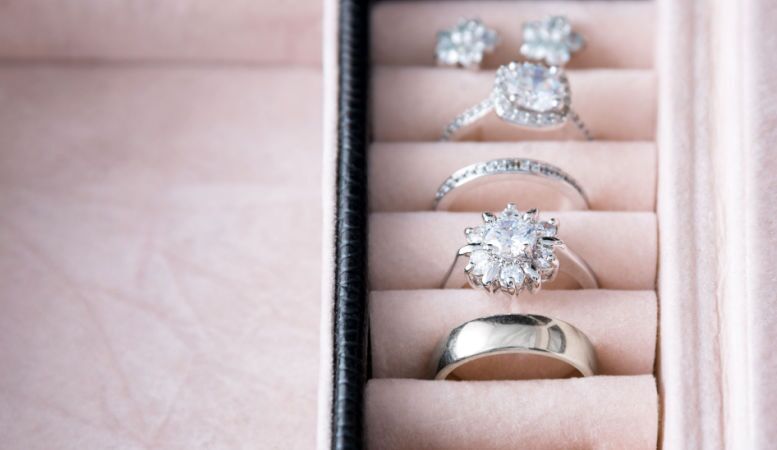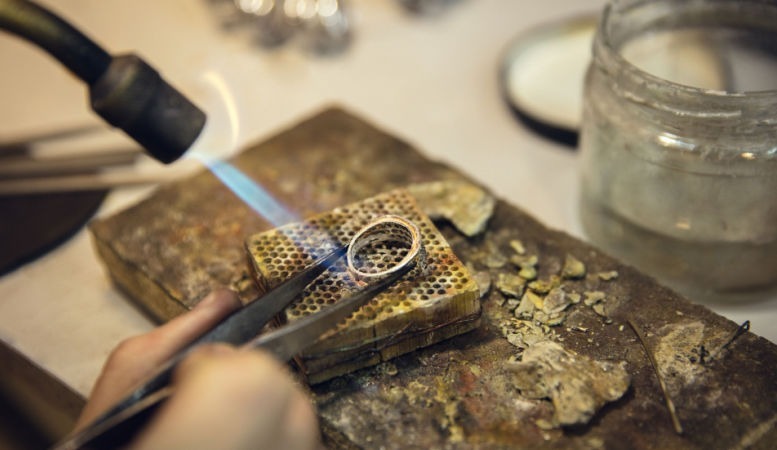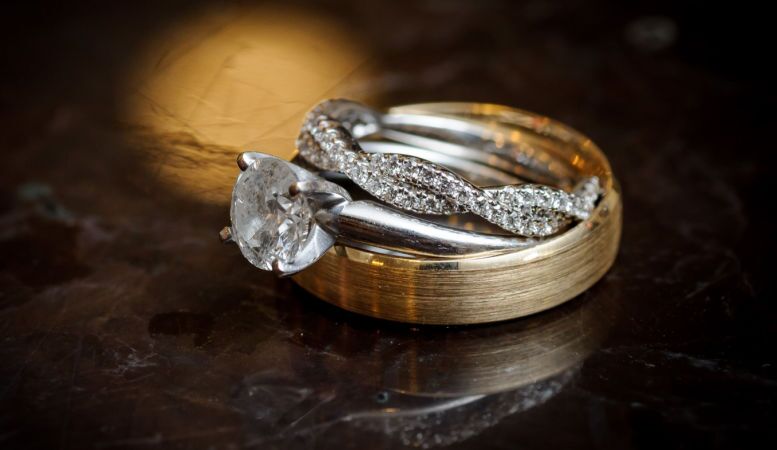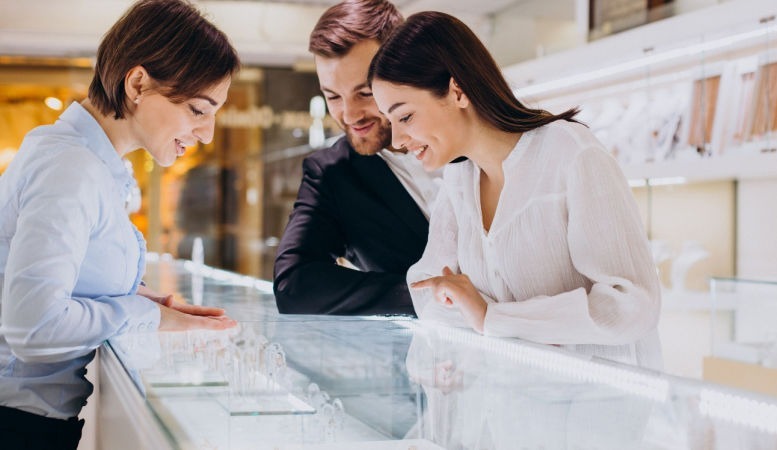Table of Contents
At first glance, the naked eye might be unable to tell the difference between white gold and sterling silver. Both are white metals with a shiny finish, and jewelry pieces made of these metals have more or less the same look.
However, upon closer inspection and research, you will find several significant differences between sterling silver vs. white gold. Understanding the differences can help you choose between these precious metals when shopping for jewelry.
In this guide on sterling silver vs. white gold, our team at the Oxford Gold Group provides an in-depth discussion on the differences between these two metals.
Sterling Silver Composition

Silver is one of the precious metals with the broadest application ranges, and it is a component of various products, including jewelry, mirrors, tableware, electronics, and solar panels.
When buying a piece of silver jewelry, you might notice a label with the term “sterling silver.” In some cases, the metal has a stamp with the number “925,” which has the same meaning.
Sterling silver has a composition that consists of 92.5% pure silver. Other metals make up the remaining 7.5% of the sterling silver composition. Copper is the most common metal for this purpose.
Silver is an inherently soft metal, and jewelry makers create alloys, such as with copper, to improve the structural strength of their jewelry pieces.
White Gold Composition
White gold has a composition that consists of yellow gold in its purest form and other metals, such as nickel, to strengthen the metal alloy. Other metals in the composition of white gold can include platinum, palladium, silver, and nickel.
The alloy gives white gold its brilliant white appearance, though jewelry pieces with a high pure gold content typically have a subtle yellow tinge.
White gold usually has a fineness or purity measurement of 14 or 18 karats. You can calculate the percentage of pure gold in a piece of white gold by dividing the number of karats by 24.
For example, 14-karat white gold consists of 58.3% pure gold. An 18-karat white gold ring is 75% pure gold and 25% other metals, such as platinum or palladium. Jewelry pieces of white gold alloy often feature a protective coat of rhodium plating.
Sterling Silver vs. White Gold: What Are the Main Differences?

Real gold and silver are both noble, soft metals that are rare, resistant to corrosion, and malleable. These metals are also durable, non-reactive, and ideal for use in jewelry.
Despite these similarities, significant differences exist between gold and silver. In the sections below, we discuss the unique characteristics of each precious metal and how they differ from each other.
Aesthetics
Both sterling silver and white gold have metallic silver or grey hues, and jewelry pieces made of these metals tend to suit people with cool blue, pink, and red skin undertones. Sterling silver is shinier than white gold.
Most people find sterling silver to be too shiny, especially in combination with diamonds and crystals. However, sterling silver is ideal for fine jewelry without stones, as it adds a shiny element to your attire.
You can expect a professional jeweler to recommend white gold for a wedding or engagement ring with a diamond. The duller complexion of this metal doesn’t detract from the stone’s appearance.
Cost
Which jewelry piece should you buy: sterling silver or white gold? To answer this question, you need to consider the cost. Gold is rarer than pure silver, and gold has always been significantly more expensive than silver.
However, a sterling silver piece, such as an engagement ring, can provide the same emotional value and longevity as a white gold piece. If you have a tight budget, opt for sterling silver.
Even though gold has a higher financial value than silver, white gold is an affordable alternative to platinum. If you want to buy a piece of jewelry with the same appearance and durability as platinum, a white gold piece is a viable option.
Durability

Your sterling silver piece can last a lifetime, even if you wear it in the shower. However, this metal requires proper care, and you need to keep your sterling silver ring or bracelet away from harsh chemicals, including your swimming pool’s chlorine.
Sterling silver is more prone to scratches than white gold, and it is a softer metal that is more likely to bend. When you remove your sterling silver jewelry, make sure that you store it in a dry location with no exposure to excessive heat.
Consider a white gold piece if you are looking for a bracelet, necklace, or ring for daily wear. White gold is more scratch-resistant than sterling silver.
The scratch resistance of white gold jewelry is partly due to rhodium plating. In addition to strengthening and protecting your white gold piece, rhodium plating gives it a palladium-like hue and shine. Rhodium also mitigates allergy risks due to nickel exposure.
Suitability for Sensitive Skins
Both white gold and silver jewelry pieces can be alloys containing nickel to enhance firmness and luster. However, nickel is an allergen that can cause a form of dermatitis. You might have a nickel allergy if you wear a white metal piece and notice irritation where your skin touches the jewelry.
Generally, white gold pieces tend to have the highest nickel content. However, a rhodium coating offers sufficient protection against nickel exposure, and you might only notice an allergic reaction once this coating wears off.
Lower-quality sterling silver might also contain nickel, increasing your risk of an allergic reaction. If you have sensitive skin, you should only consider high-quality sterling silver pieces that contain copper, a hypoallergenic alloy.
How Does White Gold Differ From Pure Yellow Gold?

The most significant difference between white gold and yellow gold is in appearance. Traditional gold has a warm yellow glow that provides an appealing contrast with the appearance of stones, such as diamonds.
Yellow gold exists naturally in pure form, and white gold needs to undergo a production process that involves the addition of alloys.
There is no real price difference between yellow and white gold, provided they have the same purity. White and yellow gold are both durable and non-reactive to environmental conditions. However, these metals’ physical and chemical properties differ due to the additional alloys in the composition of white gold.
Do Sterling Silver and White Gold Tarnish?
The non-reactivity of white gold and silver contributes to the inherent value of these metals. However, a hydrogen sulfide reaction might cause the sterling silver to tarnish and become duller. Regular contact with organic compounds containing sulfur or proteins, such as egg whites, can also cause fine silver to tarnish.
You might notice that the silver or gold jewelry you wear daily develops a patina layer. Some people like this oxidation layer and its unique appearance. However, you can always clean the piece to remove the patina and restore the white metal shine.
Other metals in sterling silver or white gold jewelry might also be susceptible to tarnishing, affecting the entire piece’s appearance. For example, copper tarnishes with use and over time, but removing the tarnish from this metal is relatively easy.
How To Clean Sterling Silver and White Gold

The easiest way to clean a sterling silver piece is by rubbing it with a designated silver polish and a soft cloth. These rubbing compounds dissolve and remove tarnish layers, then leave a protective coating behind that prevents premature tarnish build-up.
If you don’t have silver polish, you can use regular dish soap with warm water and a soft cloth. A solution consisting of one part water and three parts baking soda can also remove patina or thick tarnish layers.
Toothpaste has the same properties as a rubbing compound, and you can use it to remove a tarnish layer from your sterling silver and buff it to a shine.
White Gold vs. Silver: Which Metal Is Best for Jewelry?
Choosing between white gold and silver for a jewelry purchase can be challenging. Generally, you should choose white gold if you want a durable piece with low maintenance requirements and a long-lasting shine.
On the other hand, if you are looking for a more affordable piece and like cleaning your jewelry, consider a sterling silver piece. This metal option is also ideal if you like shinier pieces.
If you see jewelry you like, don’t be too analytical about its metal type. Ultimately, the decision to buy jewelry should be a subjective one, and the emotional value of a piece can be more significant than its economic value.
White Gold vs. Silver: Which One Is Best for Investments?

White gold generally has a higher value than sterling silver as an investment asset. Gold is a superior store of value and an inflationary hedge. When living expenses increase, so does the price of gold.
Additionally, gold tends to retain its value during deflation and geopolitical uncertainty, which is why some economists refer to gold as the “crisis commodity.”
Sterling Silver vs. White Gold Jewelry: Final Thoughts
A physical piece of white gold or sterling silver can be a valuable addition to your collection or investment portfolio. At the Oxford Gold Group, we can help you convert your existing IRA or another account into gold or other precious metals. Our team can provide you with competitive pricing and all the information you need to make calculated decisions.
Whether you want to take delivery of your bullion or convert some of your retirement savings into precious metals, we can provide you with step-by-step guidance. Call us at 833-600-4653 to start investing in white gold or sterling silver.








